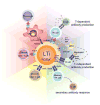Lymphoid tissue inducer-A divergent member of the ILC family
- PMID: 29454785
- PMCID: PMC6089680
- DOI: 10.1016/j.cytogfr.2018.02.004
Lymphoid tissue inducer-A divergent member of the ILC family
Abstract
Innate lymphoid cells (ILCs) that are capable of producing effector cytokines reminiscent of CD4+ T helper (Th) cells during infections and tissue inflammations have drawn much attention in the immunology field in recent years. Within the ILCs, the lymphoid tissue inducer (LTi) cells that play a critical role in lymphoid organogenesis were identified long before the establishment of the ILC concept. LTi cells, developed and functioning mainly at the fetal stage, and LTi-like cells, presumably generated during the adulthood, are regarded as a subset of type 3 ILCs (ILC3s) because they express the ILC3 lineage-defining transcription factor RORγt, and like other ILC3s, can produce an ILC3 signature cytokine IL-22 and initiate protective immune responses against extracellular bacteria. However, LTi/LTi-like cells have a unique gene expression pattern, and they develop from a progenitor that is distinct from the progenitor of all other ILCs and the progenitor of conventional natural killer (cNK) cells. There are also several other unique features of LTi/LTi-like cells comparing to non-LTi ILC3s. In addition to their classical function in lymphoid organogenesis, LTi/LTi-like cells also have specialized functions in association with the adaptive immune system, which include their effects on T and B cell development, activation and function. In this review, we summarize these specific features of LTi/LTi-like cells and propose that these cells should be considered as a separated innate lymphoid lineage in parallel with other non-LTi ILCs and cNK cells.
Keywords: Adaptive immune system; Cell development and differentiation; Cell-cell interaction; Innate lymphoid cell; Lymphoid tissue inducer; Natural killer; T helper cell; Transcriptional regulation.
Published by Elsevier Ltd.
Conflict of interest statement
The authors declare no competing financial interests.
Figures




Similar articles
-
Helper-like Innate Lymphoid Cells in Humans and Mice.Trends Immunol. 2020 May;41(5):436-452. doi: 10.1016/j.it.2020.03.002. Epub 2020 Mar 26. Trends Immunol. 2020. PMID: 32223931 Review.
-
Protocols for Innate Lymphoid Cell Phenotypic and Functional Characterization: An Overview.Methods Mol Biol. 2020;2121:1-6. doi: 10.1007/978-1-0716-0338-3_1. Methods Mol Biol. 2020. PMID: 32147781 Review.
-
The Metabolic Basis of ILC Plasticity.Front Immunol. 2022 Apr 29;13:858051. doi: 10.3389/fimmu.2022.858051. eCollection 2022. Front Immunol. 2022. PMID: 35572512 Free PMC article. Review.
-
Mouse models for the study of fate and function of innate lymphoid cells.Eur J Immunol. 2018 Aug;48(8):1271-1280. doi: 10.1002/eji.201747388. Epub 2018 Jul 17. Eur J Immunol. 2018. PMID: 29974461 Review.
-
Group 3 innate lymphoid cells (ILC3s): Origin, differentiation, and plasticity in humans and mice.Eur J Immunol. 2015 Aug;45(8):2171-82. doi: 10.1002/eji.201545598. Epub 2015 Jun 18. Eur J Immunol. 2015. PMID: 26031799 Review.
Cited by
-
Evasion of Innate Lymphoid Cell-Regulated Gamma Interferon Responses by Chlamydia muridarum To Achieve Long-Lasting Colonization in Mouse Colon.Infect Immun. 2020 Feb 20;88(3):e00798-19. doi: 10.1128/IAI.00798-19. Print 2020 Feb 20. Infect Immun. 2020. PMID: 31818961 Free PMC article.
-
Bridging Chronic Inflammation and Digestive Cancer: The Critical Role of Innate Lymphoid Cells in Tumor Microenvironments.Int J Biol Sci. 2024 Sep 9;20(12):4799-4818. doi: 10.7150/ijbs.96338. eCollection 2024. Int J Biol Sci. 2024. PMID: 39309440 Free PMC article. Review.
-
Reciprocal costimulatory molecules control the activation of mucosal type 3 innate lymphoid cells during engagement with B cells.Cell Mol Immunol. 2023 Jul;20(7):808-819. doi: 10.1038/s41423-023-01041-w. Epub 2023 May 25. Cell Mol Immunol. 2023. PMID: 37225838 Free PMC article.
-
CD4 T Helper Cell Subsets and Related Human Immunological Disorders.Int J Mol Sci. 2020 Oct 28;21(21):8011. doi: 10.3390/ijms21218011. Int J Mol Sci. 2020. PMID: 33126494 Free PMC article. Review.
-
ILC3: a case of conflicted identity.Front Immunol. 2023 Oct 17;14:1271699. doi: 10.3389/fimmu.2023.1271699. eCollection 2023. Front Immunol. 2023. PMID: 37915588 Free PMC article. Review.
References
-
- Spits H, et al. Innate lymphoid cells--a proposal for uniform nomenclature. Nat Rev Immunol. 2013;13:145–149. - PubMed
-
- Eberl G, Di Santo JP, Vivier E. The brave new world of innate lymphoid cells. Nat Immunol. 2015;16:1–5. - PubMed
-
- Moro K, et al. Innate production of T(H)2 cytokines by adipose tissue-associated c-Kit(+)Sca-1(+) lymphoid cells. Nature. 2010;463:540–544. - PubMed
Publication types
MeSH terms
Grants and funding
LinkOut - more resources
Full Text Sources
Other Literature Sources
Research Materials

